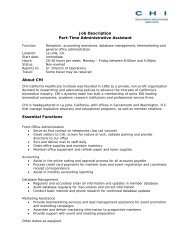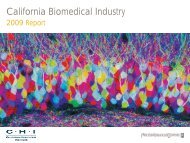California Biomedical Industry - California Healthcare Institute
California Biomedical Industry - California Healthcare Institute
California Biomedical Industry - California Healthcare Institute
Create successful ePaper yourself
Turn your PDF publications into a flip-book with our unique Google optimized e-Paper software.
View from the ground2011 CEO Survey resultsRespondents to the 2011 CEO Surveyhad a front-row seat to the financialcrisis and ensuing recession. Althoughthe recession has officially ended, itseffects continue to dampen businessoperations. In fact, over the past year,69 percent of the responding companiesreported that R&D projects had beendelayed. Among the reasons (Figure24), “funding not available” was themost prevalent at 44 percent.As for raising monies through mergersand acquisitions or divestitures,however, the respondents’ strategieswere less transparent. Thoseanticipating participating in an M&Atransaction over the next year werefairly evenly divided at 51 percent veryor somewhat unlikely and 48 percentsomewhat or very likely (Figure 25).On the other hand, only 9 percent ofrespondents said they were very likelyto participate in a sale or divestitureover the coming year, and theremainder were fairly evenly dividedamong very unlikely, somewhat unlikelyand somewhat likely (Figure 26).Although relocating out of state wasnot a strategy cited by respondents (seesurvey data in the Employment section),80 percent of the survey participantshad been courted by other countries,state governments or regional economicdevelopment associations outside of<strong>California</strong> in the past year. Among theother U.S. regions respondents said theywould consider (Figure 27), GreaterBoston ranked highest at 76 percent.With the economy and biomedicalindustry funding environment showingsome initial signs of recovery, the 2011CEO Survey sought entrepreneurs’thoughts on sustaining growth.Perceived threats to growth overthe next five years focused on theworkforce. The threat mentioned most(at 16 percent) as the highest was “lackof innovation/R&D productivity.”The threat that garnered the most topthree placements was “unpreparedworkforce” at 47 percent.<strong>California</strong> is in good stead to givecompanies confidence in staying orlocating here: As discussed in theEmployment section of this report,respondents noted the state’s workforceand culture of innovation as key benefitsof doing business in <strong>California</strong>. Themention of those attributes as boththe most beneficial for being hereand the most critical to the industry’sfuture existence reinforces how crucialongoing workforce developmentprograms are.Other high ranking threats point to thecomplexity and difficulty of thriving inthe life sciences sectors. They includelack of data or ability to demonstrateeffectiveness and product liability,with 36 percent and 35 percent ofrespondents, respectively, ranking themin the top three slots. Pricing pressureand government intervention came in at28 percent followed by access to capitalat 25 percent.Workforce development also surfacedas the single most important issuethat the state could address to retainlife sciences research, inventionand investment (Figure 28). Amongissues deemed either somewhat orextremely important, duplication ofregulations was selected by 80 percentof the respondents and workforcedevelopment by 67 percent.Drilling down into the specificcategories, the survey found that alltypes of environmental regulationswere important to respondents (Figure29). Manufacturing restrictions scoredhighest, with 48 percent finding themextremely important and 87 percentcalling them somewhat or extremelyimportant.Not surprisingly, biomedical companiesare in favor of tax incentives of all types(Figure 30). Yet among the respondentsto the 2011 CEO Survey, 67 percentsaid the R&D tax credit was extremelyimportant with only 9 percent saying itwas not important at all.Figure 24: 2011 CEO Survey: Why didFigure the company [G]: 2011 CEO delay Survey: the Why research did orthe company delay the research ordevelopment development project? project?Funding not availableRegulationChange in corporatepriorities or strategyLay-offsClosed facility2%11%18%17%44%Figure 25: 2011 CEO Survey: How likelyis your organization to take part in aFigure [H]: 2011 CEO Survey: How likely ismerger your organization or acquisition to take part over in the a merger next 12months? or acquisition over the next 12 months?Very unlikelySomewhat unlikelySomewhat likelyVery likely14%20%31%34%Figure 26: 2011 CEO Survey: Howlikely is your organization to take partin Figure a sale [I]: 2011 or divesture CEO Survey: over How the likely next is your 12months? organization to take part in a sale or divestitureover the next 12 months?Very unlikelySomewhat unlikelySomewhat likelyVery likelyFigure 27: 2011 CEO Survey: Which ofthe following do you consider to be theFigure [J]: 2011 CEO Survey: Which of themost following attractive do you consider biomedical to be the markets most forresearch attractive biomedical and development markets for research innovationin and the development U.S. outside innovation of <strong>California</strong>?in the USoutside of <strong>California</strong>?Greater BostonNorth CarolinaMinneapolis-St. PaulOtherWashington D.C. CorridorWashingtonNew YorkPhoenix9%7%6%31%25%22%20%17%28%30%33%76%16 | <strong>California</strong> <strong>Biomedical</strong> <strong>Industry</strong> 2011 Report






